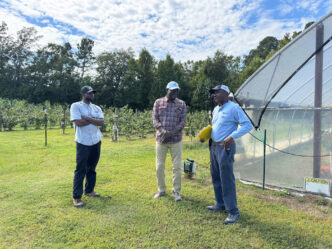Eighty percent of South Carolina livestock producers view the state’s meat processing capacity as a major hurdle for expanding their operations, according to a study conducted by Clemson Cooperative Extension.

Of the 388 producers surveyed, 47 percent sold at least some livestock as meat, typically sold from the farm, through farmers markets or other direct consumer methods such as delivery.
“The interesting part is that even the 53 percent who did not process any of their livestock for meat also saw processing capacity as a critical obstacle for the future of their business,” Agribusiness Master Extension Associate Steven Richards said.
Aimed at identifying bottlenecks in South Carolina’s meat supply and finding solutions, Clemson Cooperative Extension conducted a comprehensive local meat processing capacity study in the state from August to December 2020.
The study found 93 percent of the state’s livestock producers agreed federal legal changes are needed to allow state-inspected meat products to be shipped and sold across state lines, while about 60 percent said a lack of local processing capacity was the most significant barrier to expanding their businesses.
The COVID-19 pandemic has affected nearly all phases of American life, including a surge in demand for local meat last spring and summer. Whether this surge in demand represents a long-term shift in local meat buying is unclear, Richards said.
“Most consumers (58%) did not change their consumption of local meat due to COVID-19,” he said. “22 percent purchased more local meat and 20 percent purchased less. In the follow-up questions, a significant portion of those who purchased less did so because the meat was sold out or unavailable.”
Steps to increasing that limited capacity were also identified, as the state’s top two processors replied slaughter and processing capacities could be enhanced by 50 percent or more through modest capital investments and would create between five and ten jobs per facility.
The study also examined the final destination of the state’s meat supply: the consumer. After surveying 1,048 S.C. consumers, 78 percent said a lack of local meat availability was a reason why they did not buy more local meat, while consumers were generally not inclined to pay more than a 1-24 percent premium for local meat.
“We asked questions to consumers like, ‘Why aren’t you buying more local meat?’ Price was one reason, but availability is the other,” Richards said. “When you think about it, if you’re buying meat at a local farmers market, the hours and the time are extremely limited. If I have to be there between 8-12 on a Saturday to get my local meat, that’s an availability issue — so it’s both price and availability.”
The results of the study will be presented to the S.C. Cattlemen’s Association on Feb. 18. The Clemson Extension team then plans to assemble a roundtable discussion with the S.C. Department of Agriculture, S.C. Farm Bureau, Clemson Government Affairs, Palmetto Agribusiness Council and other key stakeholders to discuss next steps and funding to address the key findings and issues identified by the study.
Clemson plays a major role in protecting the state’s animal agriculture industry from disease and the food supply from disruption. Clemson PSA’s Livestock Poultry Health (LPH) unit inspected slaughter operations on 1,997 slaughter days that processed 37,166 livestock and more than 2.3 million poultry during 2020.
As part of LPH, the S.C. Meat-Poultry Inspection Department (SCMPID) protects the health of consumers by providing a comprehensive inspection service to assure that meat and poultry products are safe, wholesome and accurately labeled.
Richards and Matt Fischer with Clemson’s Agribusiness Team; Lee VanVlake, Travis Mitchell and Brian Beer with Clemson’s Livestock and Forages Team; and Chad Carter with Clemson’s Food Safety Team conducted the study, which was financed by Berkeley Electric Cooperative. The S.C. Cattlemen’s Association was instrumental in distributing producer surveys.
Livestock producer survey summary (388 South Carolina producers surveyed)
- Almost half (47%) of survey respondents sold some of their livestock as meat products.
- Most of these meat products are processed locally and sold directly to the consumer through word of mouth, social media and farmers markets.
- Forty-six percent of South Carolina producers used USDA-inspected processors, 28.5% used custom-exempt processors (no on-site inspection) and 25.1% used state-inspected processors.
- Thirty-five percent of respondents replied they were using processors outside of South Carolina.
- Ninety-three percent of respondents agreed legal changes were needed to allow state-inspected (SCMPID) meat products to be shipped and sold across state lines.
- Most (59.7%) livestock producers (both those selling meat and those that do not) replied that a lack of local processing capacity was the most significant barrier to expanding their businesses.
Processor Interviews (top two S.C. processors interviewed)
- Processors replied that slaughter and processing capacities could be enhanced by 50% or more through modest capital investments and would create between five and ten jobs per facility.
- Other identified issues included a lack of skilled butchers (both in skills and availability) and the fact that most processing facility owners were at or above retirement age.
Local meat consumer survey summary (1,048 S.C. consumers surveyed)
- Over 70% of consumers surveyed had consumed local meat products in the last 12 months.
- During COVID-19 supply chain disruptions, 58% of consumers purchased the same amount of local meat, 21.6% purchased more local meat and 20.4% purchased less. 30 percent of those that purchased less local meat stated that local meats were sold out.
- Seventy-eight percent of consumers stated that a lack of local meat availability (both a lack of meat supply and lack of retail sales outlets) was a reason why they did not buy more local meat.
- Consumers preferred to buy local meat at a grocery store, followed by buying it at farms and farmers’ markets. Ordering online and having meat shipped was not preferred as highly. This indicates that more retail sales outlets for local meat may help increase demand.
- Consumers were generally not inclined to pay more than a 1% to 24% premium for local meat.







